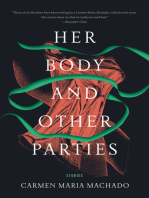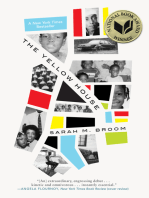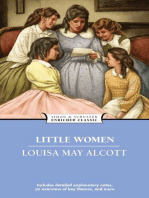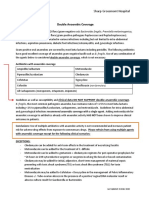Biggy Agar
Biggy Agar
Uploaded by
Matei BogdanCopyright:
Available Formats
Biggy Agar
Biggy Agar
Uploaded by
Matei BogdanCopyright
Available Formats
Share this document
Did you find this document useful?
Is this content inappropriate?
Copyright:
Available Formats
Biggy Agar
Biggy Agar
Uploaded by
Matei BogdanCopyright:
Available Formats
Section III B BG Sulfa Agar, cont.
10. Brooks and Taylor. 1955. Rep. Rd. Invest., Bd. 60, H. M. S. O. London, England. 11. Forsythe, Ayres and Radlo. 1953. Food Technol. 7:49. 12. Stadelman, Ikeme, Roop and Simmons. 1982. Poultry Sci. 61:388. 13. MacFaddin. 1985. Media for isolation-cultivation-identification-maintenance of medical bacteria, vol. 1. Williams & Wilkins, Baltimore, Md.
6. SBG Sulfa Enrichment should be used in conjunction with a selective prepared medium for bacterial identification.
References
1. Osborn and Stokes. 1955. Appl. Microbiol. 3:295. 2. Downes and Ito (ed.). 2001. Compendium of methods for the microbiological examination of foods, 4th ed. American Public Health Association, Washington, D.C. 3. DAoust, Maishment, Burgener, Conley, Loit, Milling and Purvis. 1980. J. Food Prot. 43:343. 4. DAoust. 1984. J. Food Prot. 47:588. 5. DAoust, Sewell and Boville. 1983. J. Food Prot. 46:851. 6. Moats. 1981. J. Food Prot. 44:375. 7. Federal Register. 1996. Fed. Regist. 61:38917. 8. U.S. Department of Agriculture. 1998. Microbiology laboratory guidebook, 3rd ed. Food Safety and Inspection Service, USDA, Washington, D.C. 9. Osborn and Stokes. 1955. Appl. Microbiol. 3:217.
Availability
Difco BG Sulfa Agar
CCAM COMPF USDA
Cat. No.
USDA
271710
Dehydrated 500 g
Difco SBG Sulfa Enrichment
Cat. No. 271510 Dehydrated 500 g
BiGGY Agar
Intended Use
BiGGY (Bismuth Sulfite Glucose Glycine Yeast) is a selective and differential medium used in the detection, isolation and presumptive identification of Candida species.
Principles of the Procedure
Candida species, through a process of substrate reduction, produce sulfide and bismuth which combine to produce brown to black pigmented colonies and zones of dark precipitate in the medium surrounding colonies of some species. Dextrose and yeast extract provide the nutrients in the formulation. NOTE: A decrease in pH is normal and does not affect performance.
Summary and Explanation
BiGGY Agar is based on the formulation of Nickerson.1 Nickerson developed the medium in 1953 following a study of sulfite reduction by Candida species. Differentiation of Candida is based on growth patterns and pigmentation of isolated colonies. The bismuth sulfite acts as an inhibitory agent to suppress bacterial growth, which enables the recovery of isolated colonies of Candida. Candida species reduce the bismuth sulfite, resulting in pigmentation of colonies and, with some species, pigmentation in the surrounding medium.
Formula
BBL BiGGY Agar
Approximate Formula* Per Liter Bismuth Ammonium Citrate ....................................... 5.0 Sodium Sulfite ............................................................ 3.0 Dextrose ................................................................... 10.0 Glycine ..................................................................... 10.0 Yeast Extract .............................................................. 1.0 Agar ......................................................................... 16.0
*Adjusted and/or supplemented as required to meet performance criteria.
g g g g g g
User Quality Control
Identity Specifications
BBL BiGGY Agar
Dehydrated Appearance: Solution: Medium fine, homogeneous, free of extraneous material. 4.5% solution, soluble in purified water upon boiling. Solution is light to medium, cream yellow, hazy to cloudy. Light to medium, cream yellow, hazy to cloudy. pH 6.8 0.2
Candida krusei ATCC 14243
Candida albicans ATCC 10231
Prepared Appearance: Reaction of 4.5% Solution at 25C:
Cultural Response
BBL BiGGY Agar
Prepare the medium per label directions. Inoculate with fresh cultures and incubate at 25 2C for 18-24 hours (3-5 days if necessary).
ORGANISM ATCC RECOVERY COLOR OF COLONIES/MEDIUM
Candida albicans Candida kefyr Candida tropicalis Escherichia coli
10231 8553 1369
Brown to black/ Reddish brown/ Brown to black, metallic sheen/Brown to black 25922 Partial to / complete inhibition
Good Good Good
70
Bacteroides Bile Esculin
Directions for Preparation from Dehydrated Product
1. Suspend 45 g of the powder in 1 L of purified water. Mix thoroughly. 2. Heat with frequent agitation and boil for not more than 1 minute to completely dissolve the powder. DO NOT AUTOCLAVE. 3. Cool to approximately 45-50C. Swirl to disperse the insoluble material and pour into plates. 4. Test samples of the finished product for performance using stable, typical control cultures.
SPECIES OF CANDIDA
COLONIAL MORPHOLOGY
C. albicans
Smooth, circular or hemispherical brownblack colonies; may have slight mycelial fringe; no color diffusion into surrounding medium; no metallic sheen. Smooth, discrete, dark brown to black colonies (may have black-colored centers); slight mycelial fringe; diffuse blackening of medium after 72 hours; metallic sheen. Large, flat, wrinkled silvery brown-black colonies with brown peripheries; yellow to brown halo diffusion into medium; metallic sheen. Medium size, flat, dark reddish-brown glistening colonies; may have slight mycelial fringe; no diffusion.
C. tropicalis
C. krusei
C. keyfr
Procedure
Consult appropriate references for information about the processing and inoculation of specimens such as tissues, skin scrapings, hair, nail clippings, etc. 2-5 The streak plate technique is used primarily to obtain isolated colonies from specimens containing mixed flora. When using slants, streak the surface of the slant with a sterile inoculating loop needle using two to three isolated colonies. Incubate plates in an inverted position (agar side up) for up to 5 days at 25 2C.
References
1. Nickerson. 1953. J. Infect. Dis. 93:43. 2. Haley, Trandel and Coyle. 1980. Cumitech 11, Practical methods for culture and identification of fungi in the clinical mycology laboratory. Coord. ed., Sherris. American Society for Microbiology, Washington, D.C. 3. Isenberg (ed.). 1992. Clinical microbiology procedures handbook, vol. 1. American Society for Microbiology, Washington, D.C. 4. Kwon-Chung and Bennett. 1992. Medical mycology. Lea & Febiger, Philadelphia, Pa. 5. Reisner, Woods, Thompson, Larone, Garcia and Shimizu. 1999. In Murray, Baron, Pfaller, Tenover and Yolken (ed.), Manual of clinical microbiology, 7th ed. American Society for Microbiology, Washington, D.C. 6. MacFaddin. 1985. Media for isolation-cultivation-identification-maintenance of medical bacteria, vol. 1. Williams & Wilkins, Baltimore, Md.
Expected Results
Within 5 days of incubation, the plates should show isolated colonies in streaked areas and confluent growth in areas of heavy inoculation. Slants should show evidence of growth. Examine plates and slants for colonies showing characteristic growth patterns and morphology. The following table summarizes typical Candida colonial morphology.6
Availability
BBL BiGGY Agar
Cat. No. 211027 Dehydrated 500 g United States and Canada Cat. No. 297254 Prepared Plates Pkg. of 20* 297255 Prepared Slants Pkg. of 10* Europe Cat. No. Mexico Cat. No. 255002 252563 Prepared Plates Pkg. of 20* Prepared Plates Pkg. of 10*
*Store at 2-8C.
Bacteroides Bile Esculin Agar (BBE)
Intended Use
Bacteroides Bile Esculin Agar (BBE) is recommended as a primary isolation medium for the selection and presumptive identification of the B. fragilis group.1,2 with Kanamycin and Vancomycin, have been recommended as appropriate for primary isolation.4 However, limited evidence for the presumptive identification of the B. fragilis group was provided. In 1978, Livingston et al. described a primary plating medium (BBE) which was found to provide selective recovery of the B. fragilis group and also evidence for presumptive identification.1
Summary and Explanation
Among the most frequently encountered anaerobes in human clinical infections are members of the Bacteroides fragilis group. Rapid detection and identification of these organisms is important since they have been found to be more resistant to antimicrobial therapy than other anaerobes.3 B. fragilis and B. thetaiotaomicron are the species of greatest clinical significance.3 Other species in the group include: B. caccae, B. distasonis, B. eggerthii, B. merdae, B. ovatus, B. stercoris, B. uniformis and B. vulgatus. Frequently these pathogens occur in a mixture of microorganisms which may overgrow the primary isolation medium. Selective media, such as CDC Anaerobe 5% Sheep Blood Agar
Principles of the Procedure
Bacteroides Bile Esculin Agar is a primary plating medium for the selective isolation and presumptive identification of the B. fragilis group. Selective inhibition of facultative anaerobes and most gram-negative anaerobic organisms is obtained by the presence of gentamicin and oxgall. Differentiation of the B. fragilis group is based on esculin hydrolysis, which produces esculetin and dextrose. The esculetin reacts with the iron salt (ferric ammonium citrate) contained in the medium to produce a dark brown to black complex that appears in the medium surrounding colonies of members of the B. fragilis group. 71
You might also like
- The Subtle Art of Not Giving a F*ck: A Counterintuitive Approach to Living a Good LifeFrom EverandThe Subtle Art of Not Giving a F*ck: A Counterintuitive Approach to Living a Good LifeRating: 4 out of 5 stars4/5 (6024)
- The Gifts of Imperfection: Let Go of Who You Think You're Supposed to Be and Embrace Who You AreFrom EverandThe Gifts of Imperfection: Let Go of Who You Think You're Supposed to Be and Embrace Who You AreRating: 4 out of 5 stars4/5 (1133)
- Never Split the Difference: Negotiating As If Your Life Depended On ItFrom EverandNever Split the Difference: Negotiating As If Your Life Depended On ItRating: 4.5 out of 5 stars4.5/5 (911)
- Grit: The Power of Passion and PerseveranceFrom EverandGrit: The Power of Passion and PerseveranceRating: 4 out of 5 stars4/5 (628)
- Hidden Figures: The American Dream and the Untold Story of the Black Women Mathematicians Who Helped Win the Space RaceFrom EverandHidden Figures: The American Dream and the Untold Story of the Black Women Mathematicians Who Helped Win the Space RaceRating: 4 out of 5 stars4/5 (937)
- Shoe Dog: A Memoir by the Creator of NikeFrom EverandShoe Dog: A Memoir by the Creator of NikeRating: 4.5 out of 5 stars4.5/5 (548)
- The Hard Thing About Hard Things: Building a Business When There Are No Easy AnswersFrom EverandThe Hard Thing About Hard Things: Building a Business When There Are No Easy AnswersRating: 4.5 out of 5 stars4.5/5 (359)
- Her Body and Other Parties: StoriesFrom EverandHer Body and Other Parties: StoriesRating: 4 out of 5 stars4/5 (831)
- Elon Musk: Tesla, SpaceX, and the Quest for a Fantastic FutureFrom EverandElon Musk: Tesla, SpaceX, and the Quest for a Fantastic FutureRating: 4.5 out of 5 stars4.5/5 (481)
- The Emperor of All Maladies: A Biography of CancerFrom EverandThe Emperor of All Maladies: A Biography of CancerRating: 4.5 out of 5 stars4.5/5 (275)
- The Yellow House: A Memoir (2019 National Book Award Winner)From EverandThe Yellow House: A Memoir (2019 National Book Award Winner)Rating: 4 out of 5 stars4/5 (99)
- The Little Book of Hygge: Danish Secrets to Happy LivingFrom EverandThe Little Book of Hygge: Danish Secrets to Happy LivingRating: 3.5 out of 5 stars3.5/5 (434)
- The World Is Flat 3.0: A Brief History of the Twenty-first CenturyFrom EverandThe World Is Flat 3.0: A Brief History of the Twenty-first CenturyRating: 3.5 out of 5 stars3.5/5 (2281)
- Devil in the Grove: Thurgood Marshall, the Groveland Boys, and the Dawn of a New AmericaFrom EverandDevil in the Grove: Thurgood Marshall, the Groveland Boys, and the Dawn of a New AmericaRating: 4.5 out of 5 stars4.5/5 (273)
- The Sympathizer: A Novel (Pulitzer Prize for Fiction)From EverandThe Sympathizer: A Novel (Pulitzer Prize for Fiction)Rating: 4.5 out of 5 stars4.5/5 (125)
- A Heartbreaking Work Of Staggering Genius: A Memoir Based on a True StoryFrom EverandA Heartbreaking Work Of Staggering Genius: A Memoir Based on a True StoryRating: 3.5 out of 5 stars3.5/5 (233)
- Team of Rivals: The Political Genius of Abraham LincolnFrom EverandTeam of Rivals: The Political Genius of Abraham LincolnRating: 4.5 out of 5 stars4.5/5 (235)
- On Fire: The (Burning) Case for a Green New DealFrom EverandOn Fire: The (Burning) Case for a Green New DealRating: 4 out of 5 stars4/5 (75)
- The Unwinding: An Inner History of the New AmericaFrom EverandThe Unwinding: An Inner History of the New AmericaRating: 4 out of 5 stars4/5 (45)
- Double Anaerobic Coverage Guideline AgainstDocument2 pagesDouble Anaerobic Coverage Guideline AgainstioanaNo ratings yet
- The Pathobiology of PeritonitisDocument12 pagesThe Pathobiology of PeritonitisTri PutraNo ratings yet
- Bacteremia Due To Bacteroides Fragilis Group: Distribution of Species, - Lactamase Production, and Antimicrobial Susceptibility PatternsDocument6 pagesBacteremia Due To Bacteroides Fragilis Group: Distribution of Species, - Lactamase Production, and Antimicrobial Susceptibility PatternsDdn RmaNo ratings yet
- 11 - Anaerobic BacteriaDocument68 pages11 - Anaerobic BacteriaJohanna Kate DiestroNo ratings yet
- Microbiology: Case 1 Bacterial Wound InfectionsDocument11 pagesMicrobiology: Case 1 Bacterial Wound InfectionsNIMMAGADDA, KETHANANo ratings yet
- Biggy AgarDocument2 pagesBiggy AgarMatei BogdanNo ratings yet
- Micro Bacte Part 1 Ae3 QuestionnaireDocument8 pagesMicro Bacte Part 1 Ae3 QuestionnaireElla LpndobNo ratings yet
- Metro Nida ZolDocument14 pagesMetro Nida Zolflorinela gheorghiuNo ratings yet
- Chapter 53 - Gas GangreneDocument59 pagesChapter 53 - Gas Gangrenepooja pandeyNo ratings yet

















































